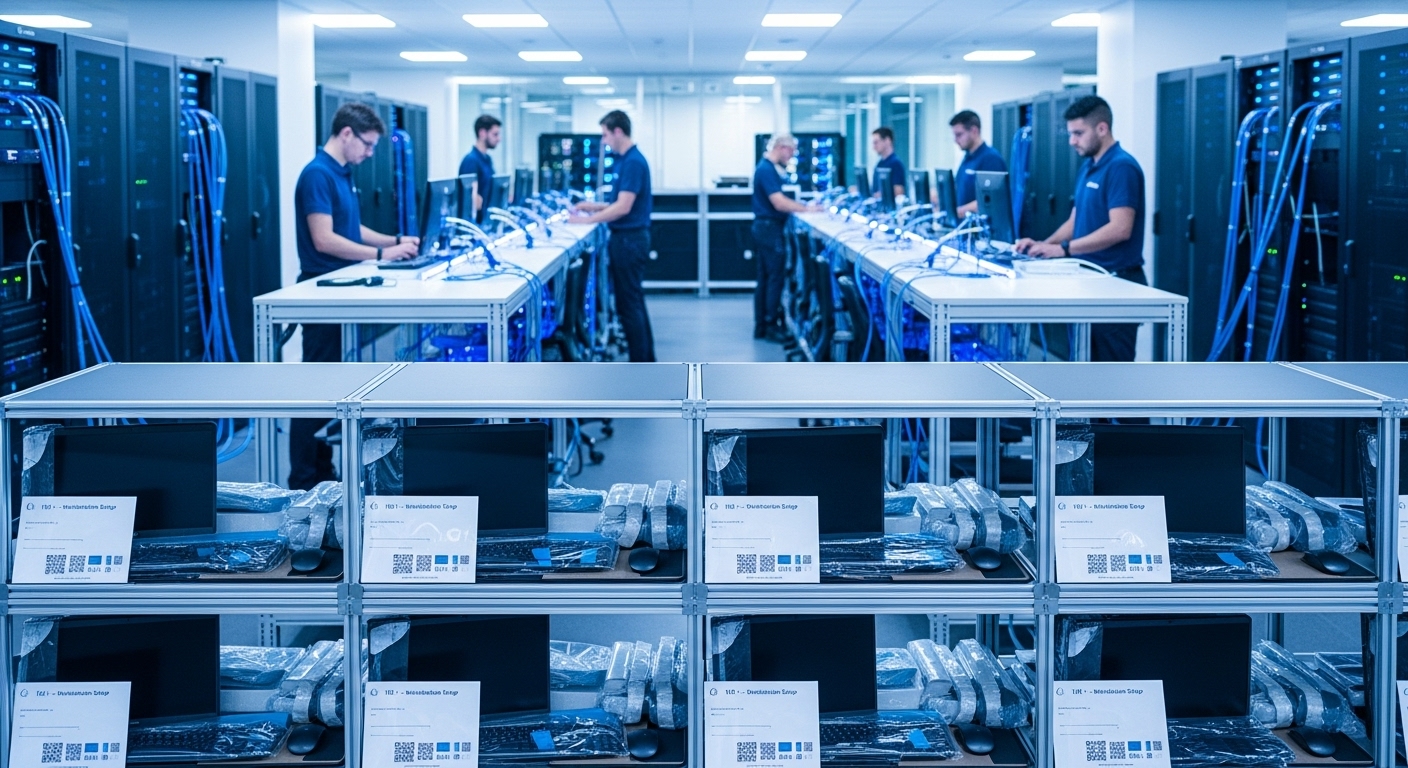Imagine the scene: a brand-new office, gleaming with potential. Employees arrive, excited to start a new chapter, only to be met with Wi-Fi that doesn’t connect, printers that can’t be found, and logins that fail. This is the costly chaos of a poorly executed IT launch. A company’s digital infrastructure is its central nervous system; if it falters, so does productivity, morale, and momentum. The success of a new workspace hinges not just on its design and location, but on the invisible yet critical web of technology that powers it. Too often, IT setup is treated as a last-minute checklist item rather than the complex logistical operation it truly is. To prevent this common pitfall, businesses need a robust, proactive strategy. This is where the Day One Doctrine comes in—a phased, logistical framework designed to ensure every aspect of your IT environment is architected, installed, and tested for flawless performance from the moment the doors open. This guide will walk you through the six essential phases, transforming a potentially frantic process into a masterclass in strategic execution, from initial assessment to seamless user onboarding.
Phase 1: Strategic Assessment & Requirements Gathering
Before a single piece of hardware is ordered or a cable is run, the foundation for a successful IT setup must be laid through meticulous planning. This initial phase is about discovery and documentation, translating business objectives into technical requirements. It begins with comprehensive stakeholder interviews. Engage with department heads from HR, finance, operations, and sales to understand their unique workflows, software dependencies, and data access needs. What tools are essential for their teams’ daily functions? What are their biggest technological pain points in the current setup? This isn’t just about replicating the old system in a new space; it’s an opportunity to optimize. The next critical step is future-proofing. Your IT infrastructure should not only serve your company today but also support its projected growth for the next three to five years. Consider scalability in terms of user count, data storage, and network bandwidth. Will you be expanding into new markets or launching data-intensive services? Factoring in these ambitions now prevents costly and disruptive upgrades down the line. Furthermore, the modern workplace demands a deep consideration of hybrid and remote work models. The network must be designed to provide secure, reliable, and equitable access for employees, whether they are at a desk in the main office, working from home, or connecting from a different continent. Finally, this phase establishes the budgetary framework and identifies any critical compliance constraints. Industries like healthcare (HIPAA) or finance (PCI DSS) have stringent data security regulations that must be baked into the infrastructure design from the very beginning, influencing everything from data encryption standards to physical server security.
Phase 2: Architectural Design & Vendor Selection
With a clear understanding of your company’s needs, the next phase is to translate those requirements into a concrete technical blueprint. This is where you architect the digital backbone of your organization. A primary decision is the cloud versus on-premise debate. A cloud-first strategy, utilizing Infrastructure as a Service (IaaS) or Software as a Service (SaaS), offers scalability, lower capital expenditure, and simplified remote access. An on-premise solution provides greater control over data and may be necessary for specific security or performance requirements. Many businesses today opt for a hybrid model, leveraging the cloud for flexibility while keeping sensitive data or critical systems in-house. Once the hosting strategy is defined, you can design the network topology. This includes mapping out the Local Area Network (LAN) and Wireless Local Area Network (WLAN), determining the placement of Wi-Fi access points for optimal coverage, and segmenting the network to isolate guest traffic from the internal corporate network. A crucial logistical component is selecting the right Internet Service Provider (ISP). Don’t just look at advertised speed; investigate reliability, service level agreements (SLAs), and customer support. Best practice dictates contracting with a secondary, backup ISP to ensure business continuity in case of an outage. Simultaneously, you must select your core hardware and software stack. This involves choosing standardized models for laptops, monitors, and peripherals to simplify support and procurement. It also means selecting and vetting key software vendors for collaboration (e.g., Microsoft 365 vs. Google Workspace), project management, and other business-critical functions. Diligent vendor selection is a risk mitigation strategy, ensuring your partners are reliable, secure, and aligned with your business goals.
Phase 3: Procurement & Logistical Coordination
This phase marks the transition from planning to action, where the architectural blueprint is converted into physical assets and logistical timelines. It requires the precision of a supply chain manager. Begin by creating a master procurement list detailing every piece of hardware, software license, and service subscription required. This includes servers, routers, switches, firewalls, access points, cabling, laptops, monitors, and even peripherals like keyboards and webcams. For each item, track the vendor, model number, quantity, cost, and, most importantly, the lead time. In today’s market, supply chain delays are common, and a six-week lead time on a critical network switch can derail your entire project timeline. Order essential long-lead items as early as possible. The next critical task is coordinating with the facilities manager and construction or renovation teams. IT logistics are intrinsically linked to the physical space. You must ensure that plans for server rooms or IT closets include adequate power, dedicated cooling systems (HVAC), and physical security measures like keycard access. Cabling pathways must be established before walls are closed and ceilings are finished. Mapping out the location of every network port and power outlet at each workstation is a granular but essential task that prevents a future littered with extension cords and Wi-Fi dead zones. During this phase, you will also finalize contracts and set up accounts with your chosen software vendors and service providers. This ensures that all necessary licenses and subscriptions are active and ready for deployment well before employees arrive, preventing delays in accessing critical tools like email and collaboration platforms.
Phase 4: Staging & Physical Implementation
Physical implementation is the most visible stage of the IT setup, but its success depends on a hidden, preparatory step: staging. Never unbox and configure equipment for the first time in its final location. Instead, designate a secure staging area—a temporary lab—where all network hardware, servers, and computers can be assembled, configured, and tested before being deployed. In this controlled environment, you can install operating systems, update firmware on routers and switches, configure security settings, and install core business applications on laptops. This assembly-line approach is vastly more efficient and allows you to identify and resolve issues, such as a defective hardware unit, without disrupting the entire office installation. Once equipment is staged and verified, the physical rollout can begin. This is a carefully choreographed process. It involves running and terminating miles of ethernet cabling, professionally mounting wireless access points in locations determined during the design phase, and installing switches and servers into their racks within the IT closet or server room. The connection to the ISP is finalized and rigorously tested for speed and stability. Following the network infrastructure deployment, the focus shifts to the workstations. Teams can systematically move through the office, unboxing and setting up the pre-configured laptops, monitors, and docking stations at each desk. Every port is tested, and each station is left clean, cabled-managed, and ready for its user. This methodical, test-as-you-go process minimizes surprises and ensures that when the final switch is flipped, the entire system works as a cohesive whole.
Phase 5: Security Hardening & System Configuration
With the physical infrastructure in place, the focus shifts to fortifying the digital environment. A network that is physically connected but not digitally secured is a wide-open door for threats. This phase is dedicated to security hardening, a multi-layered process of reducing the system’s vulnerability surface. The first line of defense is the network perimeter. This involves configuring the master firewall with strict inbound and outbound traffic rules, setting up a Virtual Private Network (VPN) for secure remote access, and implementing intrusion detection and prevention systems. Internally, endpoint protection software (next-generation antivirus and anti-malware) must be deployed and updated on every server and laptop. Mobile Device Management (MDM) solutions are essential for enforcing security policies on company-owned and personal devices (BYOD) that access the network, allowing for remote data wiping in case of loss or theft. A cornerstone of modern security is implementing robust access control policies based on the Principle of Least Privilege. This means employees are only granted access to the data and systems absolutely necessary for their job functions. This is configured through directory services like Azure Active Directory or Okta, creating user groups with specific permissions. Finally, no IT setup is complete without a comprehensive backup and disaster recovery (BDR) plan. This involves setting up automated, regular backups of all critical data—both on-premise servers and cloud application data. The BDR solution itself must be tested by performing a trial restoration to ensure that, in the event of a ransomware attack, hardware failure, or natural disaster, you can recover your operations quickly and effectively. This phase transforms your newly built infrastructure into a secure, resilient fortress.
Phase 6: User Onboarding & Go-Live Protocol
The final phase of the Day One Doctrine is entirely focused on the human element. A technologically perfect system is useless if employees don’t know how to use it or feel unsupported. A smooth transition requires a well-planned user onboarding and go-live strategy. Before the first day, prepare a ‘Day One Welcome Kit’ for each employee. This can be a digital or physical document containing essential information: their username and temporary password, instructions for connecting to the Wi-Fi, a guide to accessing key applications like email and communication platforms, and clear contact information for the IT support team. Consider creating short, accessible video tutorials for common tasks. When it’s time to go live, decide between a ‘big bang’ launch where everyone starts on the same day, or a phased approach where different teams or departments are brought online over several days. A phased approach is often less risky, as it allows the IT team to focus its resources on a smaller group of users at a time. On the first day and throughout the first week, it is critical to have visible, proactive IT support available. Having ‘floor walkers’—IT staff who are physically present and roaming the office—can dramatically reduce frustration. They can provide immediate, in-person assistance with login issues, printer setup, and other minor teething problems. This hands-on support fosters goodwill and helps employees feel productive from the very start. Finally, establish a formal feedback loop. Use surveys or informal check-ins to gather information on what’s working well and what isn’t, allowing the IT team to make rapid adjustments and optimizations to the new environment.
Conclusion: From Blueprint to Operational Beat
The successful launch of a new office’s IT infrastructure is a defining moment, setting the tone for future productivity and growth. A flawed execution creates a legacy of frustration and costly fixes, while a flawless one becomes an invisible and powerful enabler of success. The Day One Doctrine provides a structured, six-phase methodology that transforms this complex undertaking from a high-risk gamble into a predictable, manageable process. By systematically moving through strategic assessment, architectural design, procurement, implementation, security hardening, and user onboarding, an organization can methodically de-risk the entire operation. This approach underscores a critical truth: modern IT setup is not merely a technical task but a core business logistic. It’s about the strategic choreography of people, products, and processes. It requires the foresight of a strategist, the precision of a project manager, and the empathy of a user advocate. Investing the time and resources into this disciplined framework is not an expense; it is a down payment on operational resilience, employee satisfaction, and sustained momentum. When your team walks in on day one to a system that works seamlessly, you haven’t just built a network—you’ve established the strong, steady heartbeat of your new operational home, ready to power your ambitions from the very first beat.





